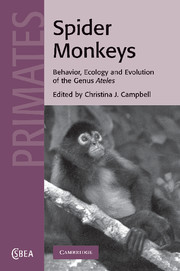Book contents
- Frontmatter
- Contents
- List of contributors
- Acknowledgements
- 1 Introduction
- Part I Taxonomy, phylogeny and evolution
- Part II Ecology
- Part III Behavior and reproduction
- 7 Locomotion and positional behavior of spider monkeys
- 8 Communication in spider monkeys: the function and mechanisms underlying the use of the whinny
- 9 Social interactions, social relationships and the social system of spider monkeys
- 10 Spider monkey reproduction and sexual behavior
- 11 Immaturity in spider monkeys: a risky business
- 12 Demography and group composition of Ateles
- Part IV Interactions with humans
- Index
- References
8 - Communication in spider monkeys: the function and mechanisms underlying the use of the whinny
Published online by Cambridge University Press: 05 May 2010
- Frontmatter
- Contents
- List of contributors
- Acknowledgements
- 1 Introduction
- Part I Taxonomy, phylogeny and evolution
- Part II Ecology
- Part III Behavior and reproduction
- 7 Locomotion and positional behavior of spider monkeys
- 8 Communication in spider monkeys: the function and mechanisms underlying the use of the whinny
- 9 Social interactions, social relationships and the social system of spider monkeys
- 10 Spider monkey reproduction and sexual behavior
- 11 Immaturity in spider monkeys: a risky business
- 12 Demography and group composition of Ateles
- Part IV Interactions with humans
- Index
- References
Summary
Introduction
Several aspects of the biology of spider monkeys (Ateles spp.) make their communication system particularly interesting. First, as canopy-dwelling, frugivorous primates, spider monkeys must forage in a complex environment consisting of fruit patches of variable size that are spatially distributed over large areas (Klein, 1972; van Roosmalen and Klein, 1987). Such an environment places a high demand on those mechanisms by which individuals can efficiently coordinate their movements, exploit their food resources and avoid danger (Milton, 2000). Additionally, because of their fluid grouping and association patterns (Aureli and Schaffner, this volume), individual spider monkeys may spend long periods of time away from others in the group (Symington, 1990; Ramos-Fernández, 2005). This implies that at times, long-distance vocalizations, which can overcome spatial separation, or olfactory marks, which can overcome temporal separation, may be the only means by which spider monkeys can locate group members and, in general, maintain their social relationships (Ramos-Fernández, 2005; Aureli et al., in press).
This chapter reviews the studies carried out so far on spider monkey communication, placing more emphasis on the vocal mode, as it has received the most attention. The first section reviews the early, more descriptive studies of communication in spider monkeys and provides a set of definitions of the different vocal types used by different species. Among the different vocalizations used by spider monkeys, only the whinny has been studied in any detail.
- Type
- Chapter
- Information
- Spider MonkeysThe Biology, Behavior and Ecology of the Genus Ateles, pp. 220 - 235Publisher: Cambridge University PressPrint publication year: 2008
References
- 16
- Cited by



